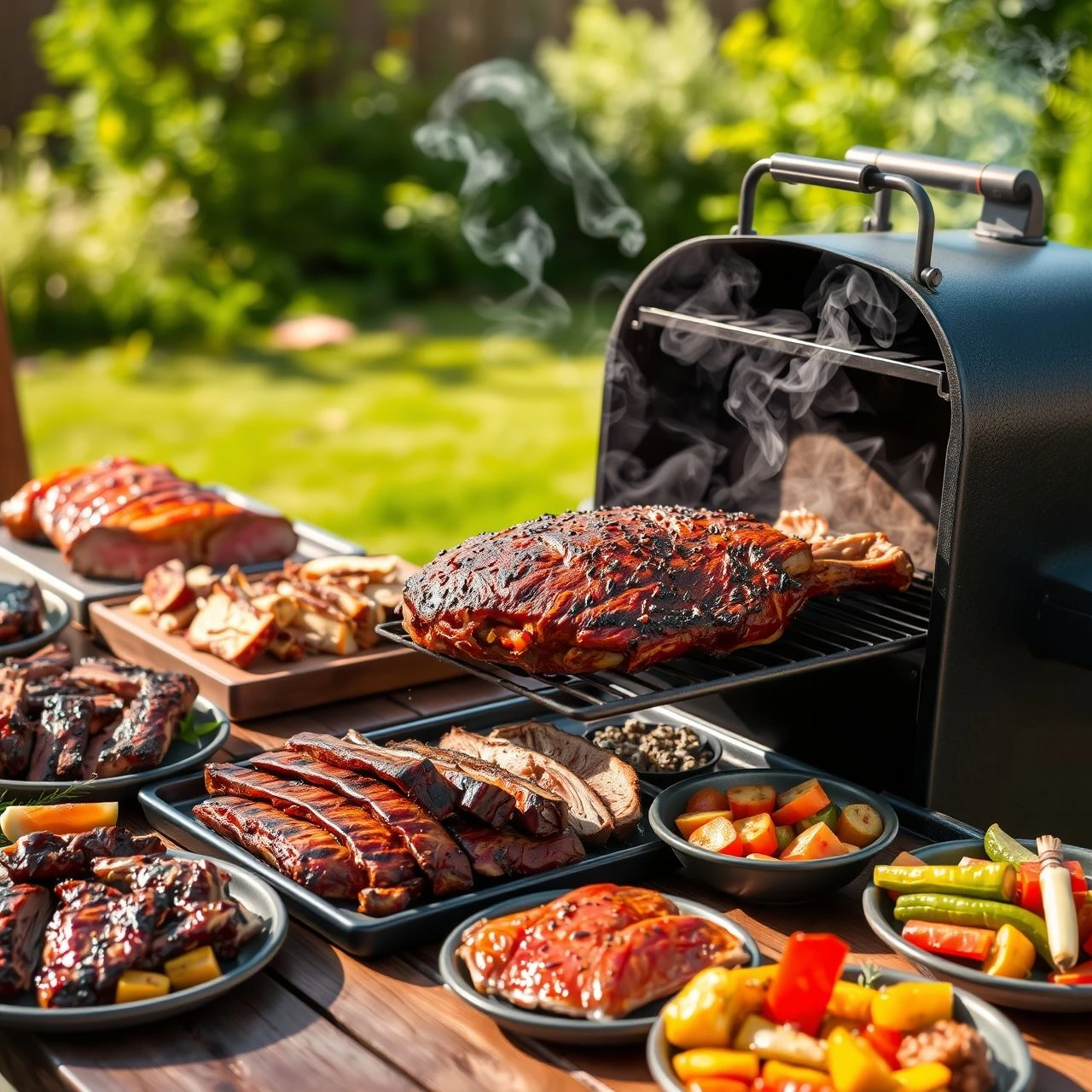Beyond the Grill: Smoker Recipes That Will Blow Your Taste Buds Away
Smoker Recipes
When you fire up your smoker, it’s more than just cooking—it’s an experience. Picture the scent of slow-cooked meats, vegetables, and seafood, infusing the air with a rich, smoky aroma that has the power to gather people together. Whether it’s for a weekend BBQ or a special family event, smoked dishes have a way of creating unforgettable moments. As you embark on this smoky journey, you’re not just preparing a meal; you’re mastering a craft, perfecting flavors, and creating memories.
In this comprehensive guide, you’ll discover how to unlock bold flavors with smoker recipes, enhance your smoking techniques, and take your grilling game to the next level. Whether you’re a beginner or a seasoned pitmaster, there’s always something new to learn in the world of smoking. Let’s dive into the basics, tips, and some of the most mouthwatering recipes you can try today.
Table of Contents
Why Smoked Recipes Are a Game Changer
The Science of Smoking
Smoking is a slow, deliberate process that transforms raw ingredients into tender, flavorful dishes. The magic happens at low temperatures, allowing the meat to absorb the smoky flavors while remaining juicy and tender. By cooking your food over time with wood chips, you’re not just infusing flavor—you’re also enhancing the texture and deepening the taste, bringing out a complexity that grilling or baking simply can’t match.
When you select the right type of wood for smoking, you’re adding a signature flavor. Different woods create different effects. For example, hickory imparts a strong, savory flavor ideal for beef and pork, while fruit woods like apple and cherry provide a mild, sweet undertone perfect for poultry and fish. The wood choice matters as much as the cooking process itself, and it’s your ticket to unlocking that smoky richness that defines great smoked food.
Healthier Cooking with a Rich Flavor Profile
Smoking is not just about creating bold flavors; it’s also a healthier cooking method. The slow cooking process helps retain the nutrients in food while rendering out excess fat. Plus, unlike frying, the meat’s natural flavors take center stage as the smoky aromas blend perfectly with the juices, delivering a richer experience. The end result? Tender, flavorful, and often healthier meals.

Getting Started with Your Smoker
Before you jump into smoking, it’s essential to understand the equipment, tools, and setup involved. Here’s how you can set yourself up for success.
Choosing the Right Smoker
Your first decision will be picking the right smoker. The world of smokers can be overwhelming with options ranging from gas, electric, to charcoal smokers. Here’s a breakdown:
- Gas Smokers: These are incredibly user-friendly, offering consistent temperatures with minimal fuss. They are perfect for beginners who want reliable, straightforward smoking.
- Charcoal Smokers: The traditionalist’s choice. While they require more attention to maintain temperature, they offer a richer smoky flavor and more versatility.
- Electric Smokers: The modern smoker. If you want convenience with consistent results, electric smokers are a solid option. However, they lack some of the flavor depth that charcoal smokers can offer.
Essential Smoking Tools
When smoking meat, you’ll need a few tools to ensure perfect results. These include:
- Digital Thermometer: To monitor the internal temperature of your meat accurately.
- Tongs and Meat Hooks: For handling hot meat with ease and preventing burns.
- Wood Chips and Chunks: Different types of wood will give your food a unique flavor profile. Soak your wood chips in water before using them to ensure they smolder and not burn.
- Spray Bottle: A simple tool used to keep the meat moist during the long smoking process, especially when smoking larger cuts like brisket.
Quick Start Guide to Smoking
If you’re using your smoker for the first time, start by preparing it properly:
- Season Your Smoker: Before using it for food, “season” your smoker by running it with a bit of oil and wood to burn off any factory residues.
- Set the Temperature: Aim for a steady temperature between 225°F and 250°F for most meats.
- Monitor and Adjust: Keep an eye on the smoker’s temperature throughout the cooking process, adjusting the airflow and wood as needed.
Smoker Recipes That Will Blow Your Mind
Now, let’s talk about the star of the show—the smoker recipes. There are countless delicious options you can try, but let’s start with some of the most popular smoked dishes.
Classic Smoked Meats
Smoked Brisket
Smoked brisket is a BBQ classic, and when done right, it’s truly a showstopper. To prepare your brisket:
- Ingredients:
- 5 lbs Beef Brisket
- ¼ cup Brown Sugar
- 2 tbsp Paprika
- 1 tbsp Garlic Powder
- Salt & Pepper to taste
- 1-2 cups Wood Chips (Oak or Hickory)
- Preparation:
- Coat the brisket with a dry rub made from brown sugar, paprika, garlic powder, salt, and pepper.
- Preheat your smoker to 225°F and add your soaked wood chips.
- Smoke the brisket for around 10-12 hours, depending on the size of the cut, or until the internal temperature reaches 195°F.
- Allow the meat to rest for at least 30 minutes before slicing.
Smoked Ribs
For tender, juicy ribs with a smoky kick, follow these steps:
- Ingredients:
- 2 racks of Baby Back Ribs
- ¼ cup Brown Sugar
- 2 tbsp Paprika
- 1 tbsp Chili Powder
- 1 tbsp Garlic Powder
- 1 tbsp Salt & Pepper
- Preparation:
- Remove the membrane from the ribs, then apply your dry rub.
- Set your smoker to 225°F and cook the ribs for about 5-6 hours, checking every hour.
- Wrap the ribs in foil for the last hour to retain moisture, then finish them unwrapped to achieve a crispy exterior.
Smoked Pulled Pork
Smoked pulled pork is ideal for sandwiches or tacos:
- Ingredients:
- 5 lbs Pork Shoulder
- 1 tbsp Mustard
- ¼ cup Brown Sugar
- 1 tbsp Salt & Pepper
- 2 cups Apple Wood Chips
- Preparation:
- Rub the pork shoulder with mustard and coat with brown sugar, salt, and pepper.
- Smoke the pork at 225°F for 10-12 hours or until it reaches 200°F internal temperature.
- Once done, pull the pork apart using forks and serve with your favorite BBQ sauce.
Smoked Seafood and Vegetables
Smoked Salmon
Salmon’s delicate texture makes it perfect for smoking. Here’s how you can make the most out of this fish:
- Ingredients:
- 1 whole Salmon Fillet
- ¼ cup Brown Sugar
- 1 tbsp Salt
- 1 tbsp Dill
- Preparation:
- Mix brown sugar, salt, and dill to create a dry brine.
- Coat the salmon with the brine and let it sit in the fridge for about 4 hours.
- Preheat your smoker to 180°F and smoke the salmon for 1-2 hours, or until it reaches an internal temperature of 140°F.
Smoked Vegetables
Try smoking vegetables like bell peppers, zucchini, and mushrooms. Here’s a simple recipe for a flavorful side:
- Ingredients:
- 2 Bell Peppers
- 2 Zucchini
- 8 oz Mushrooms
- 1 tbsp Olive Oil
- Salt & Pepper to taste
- Preparation:
- Toss vegetables in olive oil, salt, and pepper.
- Smoke at 225°F for about 30 minutes or until tender and lightly charred.
Advanced Smoker Techniques
As you grow more confident in your smoking skills, you can experiment with advanced techniques.
Smoking with Different Woods
Using the right wood can take your smoking to the next level. Some popular choices include:
- Hickory for a strong, savory flavor (perfect for pork and beef).
- Applewood for a sweet, mild smoke (best for poultry and fish).
- Cherry offers a subtle, fruity sweetness that pairs well with almost anything.
Temperature Control Tips
Mastering the smoker’s temperature is crucial for success. Use a digital thermometer to keep a close watch on the internal temperature of your meat. Most meats benefit from slow cooking at 225°F to 250°F, allowing the flavors to develop without drying out the meat.
Pitmaster Secrets
Once you’re comfortable with the basics, try some pitmaster secrets:
- Texas Crutch: Wrap your meat in foil when it reaches the “stall” stage (around 160°F) to retain moisture.
- Resting Meat: After smoking, let the meat rest for at least 30 minutes to allow the juices to redistribute.
Troubleshooting Common Smoker Issues
Even experienced smokers face occasional challenges. Here’s how to solve some of the most common problems.
- Flavor Isn’t Coming Through: If your meat isn’t absorbing enough smoke, try adding more wood chips or switching up the wood type.
- Dry Meat: Overcooking can lead to dry meat. Try spritzing with apple cider vinegar or wrapping the meat in foil to maintain moisture.
- Temperature Fluctuations: Ensure the smoker lid is tightly sealed, and check your fuel to maintain a consistent heat.
Frequently Asked Questions (FAQ)
What are the best smoker recipes for beginners?
Start with easy recipes like smoked chicken wings or pulled pork, which require minimal preparation and are forgiving if you’re new to smoking.
Can you smoke vegetables on a smoker?
Absolutely! Vegetables like peppers, onions, and mushrooms absorb the smoky flavor beautifully and make for a great side dish.
How long should I smoke meat for?
The cooking time depends on the cut of meat. For example, a brisket might take up to 12 hours, while chicken breasts will only need 2-3 hours.
How do I get the perfect smoky flavor?
Use fresh, quality wood chips, and maintain a steady low temperature throughout the cooking process. Experiment with different woods to find your ideal flavor profile.
Conclusion
Smoking food isn’t just about cooking; it’s about creating a unique, flavorful experience. By understanding the basics of smoking, selecting the right smoker, and experimenting with different recipes and woods, you’ll soon be creating dishes that burst with bold, smoky flavors. Don’t be afraid to try new recipes, tweak your techniques, and discover what works best for you. So, fire up your smoker, and start creating memories with every meal you smoke!
Ready to Get Smoking?
Now that you have all the tools and recipes you need, it’s time to fire up your smoker and let the delicious adventure begin. Embrace the art of smoking, and enjoy the bold flavors it brings to your table. Happy smoking!

